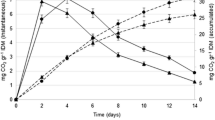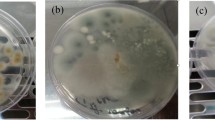Abstract
Trichoderma sp. strain Evx1 was isolated from a semi-deciduous forest soil in Southern Italy. It decolorizes polynuclear organic dyes and tolerates high concentrations of phenanthrene, anthracene, fluoranthene, and pyrene. The ability of this ascomycete fungus to degrade polycyclic aromatic hydrocarbons was verified in vitro and confirmed by its strong phenoloxidase activity in the presence of gallic acid. Phylogenetic characterization of Trichoderma sp. Evx1 positioned this strain within the species Trichoderma longibrachiatum. The potential use of this species for the bioremediation of contaminated environmental matrices was tested by inoculating diesel-spiked soil with a dense mycelial suspension. The biodegradation percentage of the C12-40 hydrocarbon fraction in the inoculated soil rose to 54.2 ± 1.6 %, much higher than that in non-inoculated soil or soil managed solely by a combination of watering and aeration. The survival and persistence of T. longibrachiatum Evx1 throughout the bioremediation trial was monitored by PCR-DGGE analysis. The fungal strain was still present in the soil 30 days after bioaugmentation. These findings indicate that T. longibrachiatum Evx1 may be a suitable inoculum in bioremediation protocols for the reclamation of soils contaminated by complex mixtures of hydrocarbons.




Similar content being viewed by others
References
Akladious SA, Abbas SM (2012) Application of Trichoderma harziunum T22 as a biofertilizer supporting maize growth. Afr J Biotechnol 11:8672–8683
Altschul SF, Madden TL, Schäffer AA, Zhang J, Zhang Z, Miller W, Lipman DJ (1997) Gapped BLAST and PSI-BLAST: a new generation of protein database search programs. Nucleic Acids Res 25:3389–3402
Anastasi A, Prigione V, Cas L, Casieri L, Varese GC (2009) Decolourisation of model and industrial dyes by mitosporic fungi in different culture conditions. World J Microbiol Biotechnol 25:1363–1374
Andreolli M, Lampis S, Zenaro E, Salkinoja-Salonen M, Vallini G (2011) Burkholderia fungorum DBT1: a promising, bacterial strain for bioremediation of PAHs-contaminated soils. FEMS Microbiol Lett 319:11–18
Andreolli M, Lampis S, Brignoli P, Vallini G (2015) Bioaugmentation and biostimulation as strategies for the bioremediation of a burned woodland soil contaminated by toxic hydrocarbons: a comparative study. J Environ Manage 153:121–131
Argumedo-Delira R, Alejandro Alarcón A, Ferrera-Cerrato R, Almaraz JJ, Peña-Cabriales JJ (2012) Tolerance and growth of 11 Trichoderma strains to crude oil, naphthalene, phenanthrene and benzo[a]pyrene. J Environ Manage 95:S291–S299
Arun A, Eyini M (2011) Comparative studies on lignin and polycyclic aromatic hydrocarbons degradation by basidiomycetes fungi. Bioresource Technol 102:8063–8070
Awodele O, Akintonwa A, Olayemi SO, Anyakora C, Afolayan GO, Olofinnade AT, Smith SI, Omonigbehin EA, Coker HAB (2010) Mutagenic screening of crude oil fractions using modified Ames test and Allium cepa (Linn) assay. Am J Pharmacol Toxicol 5:1–8
Bouchez T, Patureau D, Dabert P, Juretschko S, Doré J, Delgenèz P, Moletta R, Wagner M (2000) Ecological study of a bioaugmentation failure. Environ Microbiol 2:179–190
Carrera LV (2010) Two ex situ fungal technologies to treated contaminated soil. Ph. D. Thesis, The University of Helsinki, pp 47–50
Carvalho MB, Martins I, Leitão MC, Garcia H, Rodrigues C, San Romão V, McLellan I, Hursthouse A, Silva Pereira C (2009) Screening pentachlorophenol degradation ability by environmental fungal strains belonging to the phyla Ascomycota and Zygomycota. J Ind Microbiol Biotechnol 36:1249–1256
Cobas M, Ferreira L, Tavares T, Sanromán MA, Pazos M (2013) Development of permeable reactive biobarrier for the removal of PAHs by Trichoderma longibrachiatum. Chemosphere 91:711–716
Dhouib A, Hamza M, Zouari H, Mechichi T, Hmidi R, Labat M, Martinez MJ, Sayadi S (2005) Screening for ligninolytic enzyme production by diverse fungi from Tunisia. World J Microb Biot 21:1415–1423
Druzhinina IS, Komoń-Zelazowska M, Kredics L, Hatvani L, Antal Z, Belayneh T, Kubicek CP (2008) Alternative reproductive strategies of Hypocrea orientalis and genetically close but clonal Trichoderma longibrachiatum, both capable of causing invasive mycoses of humans. Microbiology 154:3447–3459
Druzhinina IS, Komoń-Zelazowska M, Atanasova L, Seidl V, Kubicek CP (2010) Evolution and ecophysiology of the industrial producer Hypocrea jecorina (anamorph Trichoderma reesei) and a new sympatric agamospecies related to it. PLoS One 5:e9191
Druzhinina IS, Komoń-Zelazowska M, Ismaiel A, Jaklitsch W, Mullaw T, Samuels GJ, Kubicek CP (2012) Molecular phylogeny and species delimitation in the section Longibrachiatum of Trichoderma. Fungal Genet Biol 49:358–368
El Fantroussi S, Agathos SN (2005) Is bioaugmentation a feasible strategy for pollutant removal and site remediation? Curr Opin Microbiol 8:268–275
Feltrer R, Álvarez-Rodríguez ML, Barreiro C, Godio RP, Coque J-R (2010) Characterization of a novel 2,4,6-trichlorophenolinducible gene encoding chlorophenol O-methyltransferase from Trichoderma longibrachiatum responsible for the formation of chloroanisoles and detoxification of chlorophenols. Fungal Genet Biol 47:458–467
Fijalkowski K, Kacprzak M, Bien J, Janecka B (2008) The enhanced bioremediation of soil contaminated with high concentration of diesel oil. Proceeding of the 7th International Conference of Environmental Engineering, Vilnius, Lithuania, pp 126–133
Firdaus-e-Bareen, Shafiq M, Jamil S (2012) Role of plant growth regulators and a saprobic fungus in enhancement of metal phytoextraction potential and stress alleviation in pearl millet. J Hazard Mater 237–238:186–193
Fu Y, Viraraghavan T (2001) Fungal decolorization of dye wastewater: a review. Bioresource Technol 79:251–262
Gestel KV, Mergaert J, Swingsb J, Coosemansa J, Ryckeboera J (2003) Bioremediation of diesel oil-contaminated soil by composting with biowaste. Environ Pollut 125:361–368
Giridhar Babu A, Shea P, Oh B-T (2014) Trichoderma sp. PDR1-7 promotes Pinus sylvestris reforestation of lead-contaminated mine tailing sites. Sci Total Environ 476–477:561–567
Gupta VK, Schmoll M, Herrera-Estrella A, Upadhyay RS, Druzhinina I, Tuohy MG (2014) Biotechnology and biology of Trichoderma. Elsevier, Waltham (MA, USA), Kidlington (Oxford, UK) and Amsterdam (The Netherlands)
Hong JW, Park JY, Gadd GM (2010) Pyrene degradation and copper and zinc uptake by Fusarium solani and Hypocrea lixii isolated from petrol station soil. J Appl Microbiol 108:2030–2040
Jaklitsch WM (2009) European species of Hypocrea. Part I. The green-spored species. Stud Mycol 63:1–91
Jayasinghe C, Imtiaj A, Lee GW, Im KH, Hur H, Lee MW, Yang H-S, Lee T-S (2008) Degradation of three aromatic dyes by white rot fungi and the production of ligninolytic enzymes. Mycobiology 36:114–120
Kubicek CP, Komon-Zelazowska M, Druzhinina IS (2008) Fungal genus Hypocrea/Trichoderma: from barcodes to biodiversity. J Zhejiang Univ Sci B 9:753–763
Lee H, Jang Y, Choi Y-S, Kim M-J, Lee J, Lee H, Hong J-H, Lee Y, Kim G-H, Kim J-J (2014) Biotechnological procedures to select white rot fungi for the degradation of PAHs. J Microbial Meth 97:56–62
Lindeberg G (1948) On the occurrence of polyphenol oxidases in soilinhabiting basidiomycetes. Physiol Plantarum 1:196–205
Lopez MJ, Vargas-García MC, Suárez-Estrella F, Nichols NN, Dien BS, Moreno J (2007) Lignocellulose-degrading enzymes produced by the ascomycete Coniochaeta ligniaria and related species: application for a lignocellulosic substrate treatment. Enzyme Microb Technol 40:794–800
Ma X-K, Ding N, Peterson EC (2015) Bioaugmentation of soil contaminated with high-level crude oil through inoculation with mixed cultures including Acremonium sp. Biodegradation 26:259–269
Mancera-Lòpez ME, Esparza-García F, Chávez-Gòmez B, Rodríguez-Vázquez R, Saucedo-Castañeda G, Barrera-Cortés J (2008) Bioremediation of an aged hydrocarbon-contaminated soil by a combined system of biostimulation–bioaugmentation with filamentous fungi. Int Biodeter Biodegr 61:151–160
McKee RH, Plutnick RT (1989) Carcinogenic potential of gasoline and diesel engine oils. Fundam Appl Toxicol 13:545–553
Mishra A, Nautiyal CS (2009) Functional diversity of the microbial community in the rhizosphere of chickpea grown in diesel fuel spiked soil amended with Trichoderma ressei using sole-carbon source utilization profiles. World J Microbiol Biotechnol 25:1175–1180
Mohsenzadeh F, Nasseri S, Mesdaghinia A, Nabizadeh R, Chehregani A, Zafari D (2009) Identification of petroleum resistant plants and rhizospheral fungi for phytoremediation petroleum contaminated soils. J Japan Petrol Inst 52:198–204
Mukherjee PK, Horwitz BA, Singh US, Mukherjee M, Schmoll M (2013) Trichoderma: biology and applications. CABI, Wallingford (UK) and Boston (MA, USA)
Obuekwe CO, Badrudeen AM, Al-Saleh E, Mulder JL (2005) Growth and hydrocarbon degradation by three desert fungi under conditions of simultaneous temperature and salt stress. Intern Biodeter Biodeg 56:197–206
Okoh AI, Trejo-Hernandez MR (2006) Remediation of petroleum hydrocarbon polluted systems: exploiting the bioremediation strategies. African J Biotechnol 5:2520–2525
Onofre SB, Steilmann P (2012) Phenoloxidases produced by endophytic fungi isolated from Baccharis Dracunculifolia D. C. (Asteraceae). Resources Environ 2:271–274
Oros-Sichler M, Gomes NCM, Neuber G, Smalla K (2006) A new semi-nested PCR protocol to amplify large 18S rRNA gene fragments for PCR-DGGE analysis of soil fungal communities. J Microbial Met 65:63–75
Rosales E, Pérez-Paz A, Vázquez X, Pazos M, Sanromán MA (2012) Isolation of novel benzo[a]anthracene-degrading microorganisms and continuous bioremediation in an expanded-bed bioreactor. Bioprocess Biosyst Eng 35:851–855
Saeed A, Iqbal M, Zafar SI (2009) Immobilization of Trichoderma viride for enhanced methylene blue biosorption: batch and column studies. J Hazard Mater 168:406–415
Samuels GJ, Ismaiel A, Mulaw TB, Szakacs G, Druzhinina IS, Kubicek CP, Jaklitsch WM (2012) The Longibrachiatum Clade of Trichoderma: a revision with new species. Fungal Divers 55:77–108
Schnick RA (1988) The impetus to register new therapeutics for aquaculture. Prog Fish-Cult 50:190–196
Schuster A, Schmoll M (2010) Biology and biotechnology of Thrichoderma. Appl Microbiol Biotechnol 87:787–799
Sivasamy A, Sundarabal N (2011) Biosorption of azo dye by Aspergillus niger and Trichoderma sp. fungal biomasses. Curr Microbiol 62:351–357
Smith JR (1960) The influence of antagonistic fungi on Thielaviopsis basicola (Berk. et Br.) Ferraris. Acta Bot Neerl 9:59–118
Tamura K, Peterson D, Peterson N, Stecher G, Nei M, Kumar S (2011) MEGA5: molecular evolutionary genetics analysis using maximum likelihood, evolutionary distance, and maximum parsimony methods. Mol Biol Evol 28:2731–2739
Tan KH (2005) Soil sampling, preparation and analysis, 2nd edn. Taylor & Francis, Boca Raton, USA
Tanzadeh J, Haghighat A (2014) Aplication of Bacillus subtilis in degradation of diesel oil at polluted soil in Gilan. J Curr Res Sci 2:971–976
Thompson JD, Gibson TJ, Plewniak F, Jeanmougin F, Higgins DG (1997) The CLUSTAL_X windows interface: flexible strategies for multiple sequence alignment aided by quality analysis tools. Nucleic Acids Res 25:4876–4882
Tripathi P, Singh PC, Mishra A, Chauhan PS, Dwivedi S, Bais RT, Tripathi RD (2013) Trichoderma: a potential bioremediator for environmental clean up. Clean Techn Environ Policy 15:541–550
UNI-EN ISO 16703 (2011) Soil quality - Determination of content of hydrocarbon in the range C10 to C40 by gas chromatography. European Standard
US EPA, Method 3510C, (1996) Separatory funnel liquid–liquid extraction. <http:// www.epa.gov/wastes/hazard/testmethods/sw846/pdfs/3510c.pdf>
US EPA, Method 8270D, (2007) Semivolatile Organic Compounds by GC/MS. <http://www.epa.gov/wastes/hazard/testmethods/sw846/pdfs/8270d.pdf>
Van Elsas JD, Duarte GF, Keijzer-Wolters A, Eric Smit E (2000) Analysis of the dynamics of fungal communities in soil via fungal-specific PCR of soil DNA followed by denaturing gradient gel electrophoresis. J Microbial Met 43:133–151
Vinale F, Nigro M, Sivasithamparam K, Flematti G, Ghisalberti EL, Ruocco M, Varlese R, Marra R, Lanzuise S, Eid A, Woo SL, Lorito M (2013) Harzianic acid: a novel siderophore from Trichoderma harzianum. FEMS Microbiol Lett 347:123–129
White TJ, Bruns T, Lee S, Taylor JW (1990) Amplification and direct sequencing of fungal ribosomal RNA genes for phylogenetics. In: Innis MA, Gelfand DH, Sninsky JJ, White TJ (eds) PCR protocols: a guide to methods and applications. Academic Press Inc, San Diego, Calif, pp 315–322
Yabuki T, Miyazaki K, Okuda T (2014) Japanese species of the Longibrachiatum Clade of Trichoderma. Mycoscience 55:196–212
Yao L, Teng Y, Luo Y, Christie P, Ma W, Liu F, Wu Y, Luo Y, Li Z (2015) Biodegradation of polycyclic aromatic hydrocarbons (PAHs) by Trichoderma reesei FS10-C and effect of bioaugmentation on an aged PAH-contaminated soil. Biorem J 19:9–17
Zafra G, Moreno-Montaño A, Ablasón ÁE, Cortés-Espinosa DV (2015) Degradation of polycyclic hydrocarbons in soil by a tolerant strain of Trichoderma asperellum. Environ Sci Pollut Res 22:1034–1042
Acknowledgments
This study was carried out as a part of the Microbially-Stimulated Wildfire Impact Remediation (MICROS-WILDFIRE) project, with financial support from the University of Verona and Eurovix S.p.A. (Viale Enrico Mattei 17 24060 Entratico BG Italy) under the Joint Project 2011 initiative.
Author information
Authors and Affiliations
Corresponding authors
Ethics declarations
Conflict of interest
The authors declare that they have no conflict of interest.
Additional information
Responsible editor: Robert Duran
Rights and permissions
About this article
Cite this article
Andreolli, M., Lampis, S., Brignoli, P. et al. Trichoderma longibrachiatum Evx1 is a fungal biocatalyst suitable for the remediation of soils contaminated with diesel fuel and polycyclic aromatic hydrocarbons. Environ Sci Pollut Res 23, 9134–9143 (2016). https://doi.org/10.1007/s11356-016-6167-6
Received:
Accepted:
Published:
Issue Date:
DOI: https://doi.org/10.1007/s11356-016-6167-6




